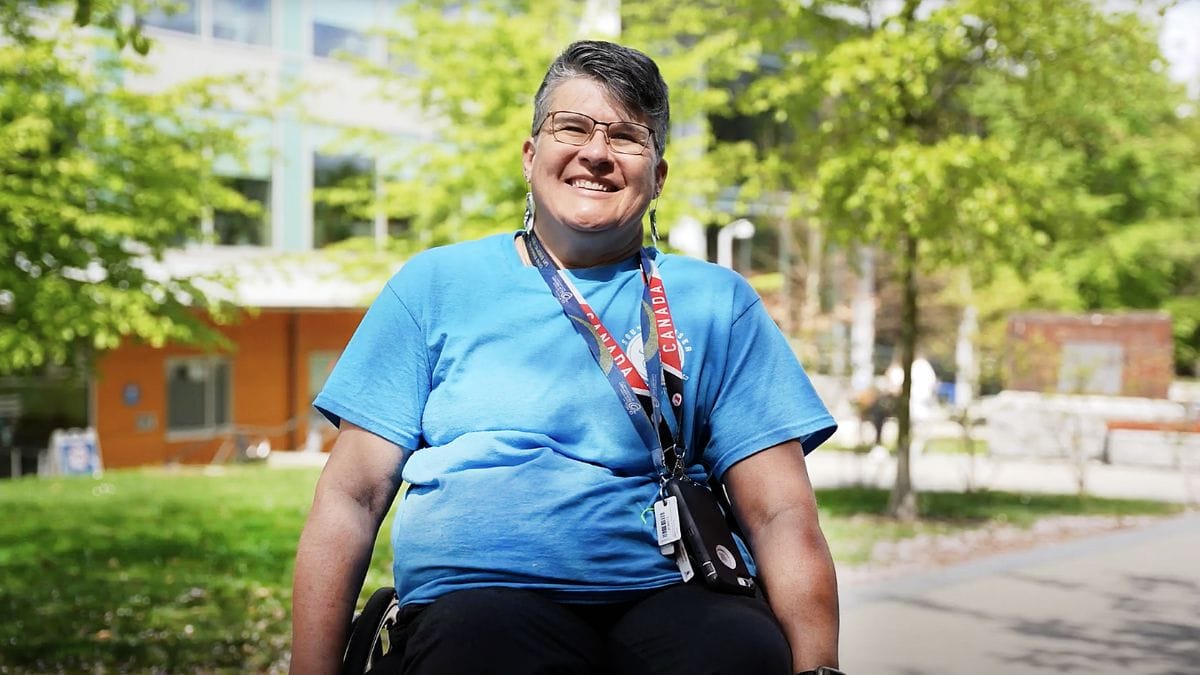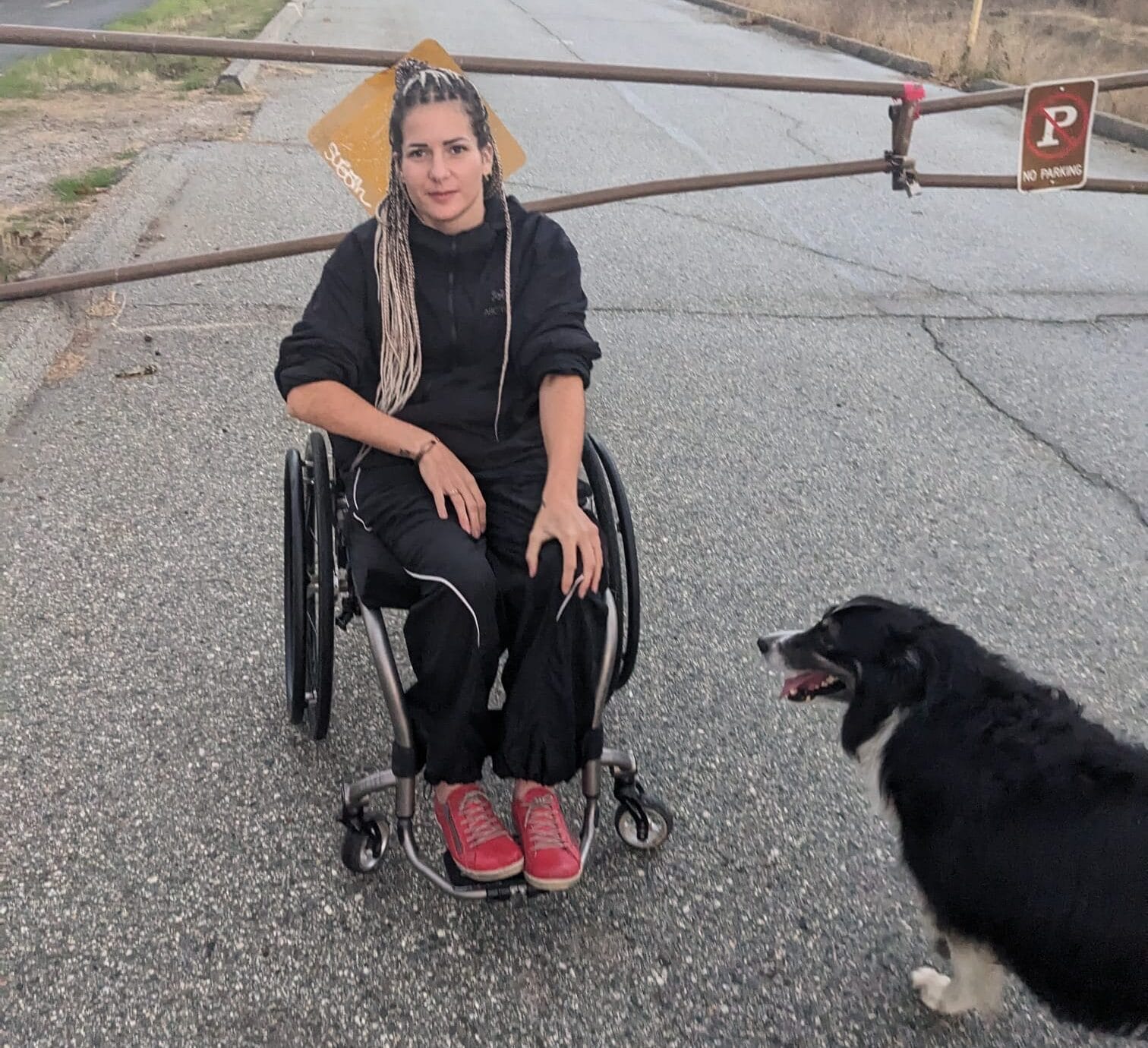
In 2022, SCI BC’s Access BC team visited the Tse’K’wa National Historic Site, formerly known as the Charlie Lake Cave, just outside Fort St. John in Northern BC. The importance of the site goes back more than 13,000 years, when a massive boulder broke off from the surrounding sandstone and revealed a small cave while creating a 12-meter-long gully on the hill. Over time, Dane-zaa ancestors made use of the cave and, as the gully filled with layers of soil, they left behind a wealth of artifacts, including a 10,500-year-old stone bead, spear and arrow points, harpoon heads, and bones from various animals. The excavation of these artifacts between 1974 and 1991 reinforced the spiritual and historical significance of the area to the Dane-zaa people of that region and are some of the most important archaeological findings in North America. Three First Nations jointly purchased the property in 2012 and established the Tse’K’wa Heritage Society. In 2019, the cave was officially designated a national historic site by Parks Canada.
The purpose during Access BC’s visit last year was to provide an accessibility assessment of the site for the Tse’K’wa Heritage Society using an auditing app currently in development through a partnership between the University of Northern BC and SCI BC. The app enables users to capture accessibility data for outdoor and recreational environments based on a set of recognized standards in Canada, such as height, building dimensions, surface grades, and more. When completed, Access BC’s Tse’K’wa assessment included best practice recommendations for entrance and exit routes, accessible bathrooms, parking improvements and more.

“Access BC’s accessibility assessment has served as our roadmap for inclusive improvements to our site. Having a list of recommended priorities has allowed us to focus our efforts on the improvements that will have the greatest, immediate impact,” says Alysa Currie, Executive Director of Tse’K’wa Heritage Society. Using the guidance provided by Access BC, Tse’K’wa has installed two accessible parking spots, a patio ramp, two universally designed outhouses, two accessible picnic spaces, a universally designed trail connecting parking and outhouses, a low-mobility access trail and entry to an archaeology dome, and a low-mobility trail to a hands-on teaching old camp known as kwą̂-ẕâa watsáádzéʔ in Dane-zaa Ẕáágéʔ language. The changes made to the site are nothing short of transformative. “We did the original consultation when there wasn’t much [infrastructure] there… they needed to build and start some places from the ground up,” explains Nancy Harris, SCI BC’s Regional Development Liaison and lead of its Access BC team. “They really have embraced this and have done a lot of improvement.”

One of the most exciting improvements is an amphitheater that will host cultural events and provide a much-needed space for community gatherings. “Accessibility is a spectrum, not all-or-nothing,” Currie says. “Access BC has been incredibly encouraging as we work towards creating a site that is as inclusive as possible … Lori Slater, Access BC team member and Access and Inclusion Liaison for the Northern BC Tourism Association, has been particularly helpful as she has visited our site multiple times to provide input and support throughout the construction process.”

Slater, who has been involved since day one with the project at Tse’K’wa, previously wasn’t able to explore some parts of the site due to uneven ground or inclines. Now, she can access the information and cultural programming provided in the dome feature and learn more about the archaeological site and Indigenous knowledge. In this way, the experience of incorporating accessibility has been mutually beneficial – the Tse’K’wa Heritage Society has learned more about universal design, and Access BC has learned more about the geographical, cultural, and historical importance of the location. As Currie notes, “[The Access BC assessment] has also been a powerful conversation starter, giving us the appropriate language to discuss access and inclusion on our site.”

This process has not been without its challenges, however. There have been various financial, geographical and logistical hurdles to overcome when trying to create a universally accessible site. For example, the entrance to the cave is located on the side of a hillside with a steep, naturally formed pathway through trees. Although the simplest solution would be to redirect the path or alter the location, that wasn’t possible. “The biggest challenge we have faced so far has been balancing the need for accessible infrastructure and the preservation of a known archaeological site,” Currie says. “Tse’K’wa [is] protected under the Heritage Conservation Act. As a result, all infrastructure has to be built while minimizing ground disturbance and ensuring any impacts are monitored and documented by our archaeologists. It has been pleasantly surprising to see the creative problem solving that has resulted from bringing together our accessibility experts, archaeologists, and external contractors.”

As upgrades continue to move forward, Access BC will remain in contact with the Tse’K’wa Heritage Society and will revisit the site as the accessibility app evolves. Ultimately, the goal is to return to Tse’K’wa when accessibility updates are complete, and the fully developed app can be used to reassess the location and gather data. “Inclusive design benefits everyone,” Currie says. “It has been interesting to see how accessible infrastructure improves everyone’s experience of the site, not just visitors with disabilities. This work has prompted a lot of quality conversations about what it means to be a welcoming, inclusive space.” Access BC looks forward to continuing to be a driving force behind this conversation and action.
Learn more about Access BC at www.sci-bc.ca/access-bc or reach out to Nancy at nharris@sci-bc.ca. Contact the Tse’K’wa Heritage Society at tsekwaheritage@gmail.com, (250) 224-7906 or www.treaty8.bc.ca/tsekwa to find out more about the Society and the archaeological site.
This article was originally published in the Fall 2023 issue of The Spin. Read more stories from this issue, including:
- Virtual reality research
- Aging with SCI
- Racecar driving
And more!




